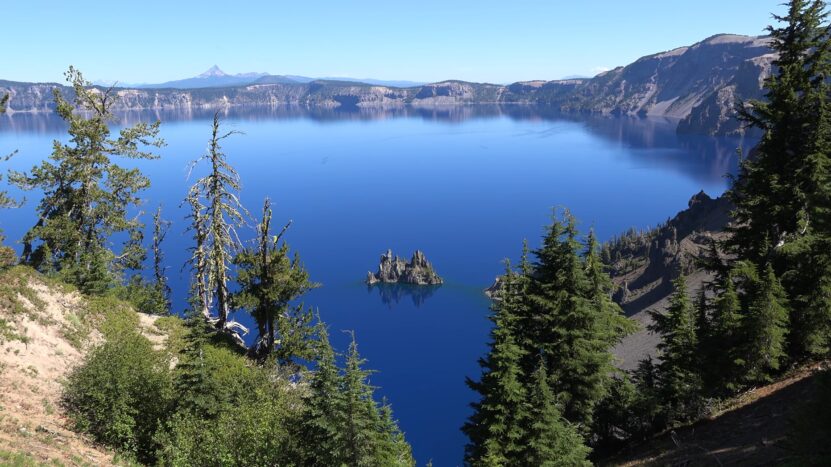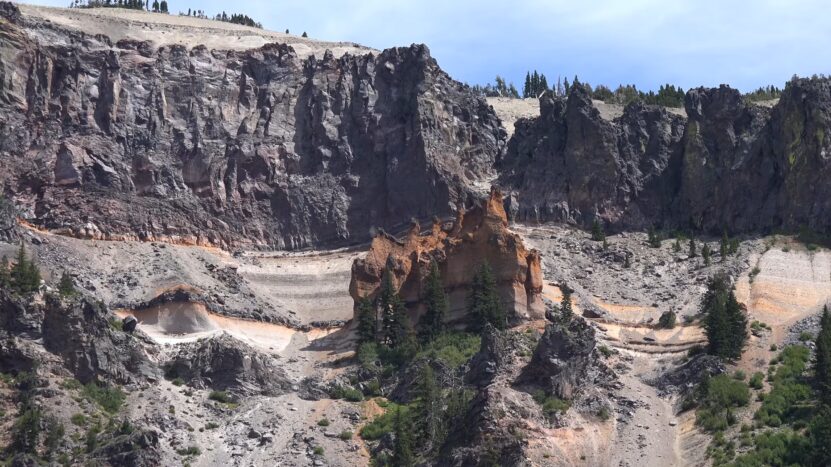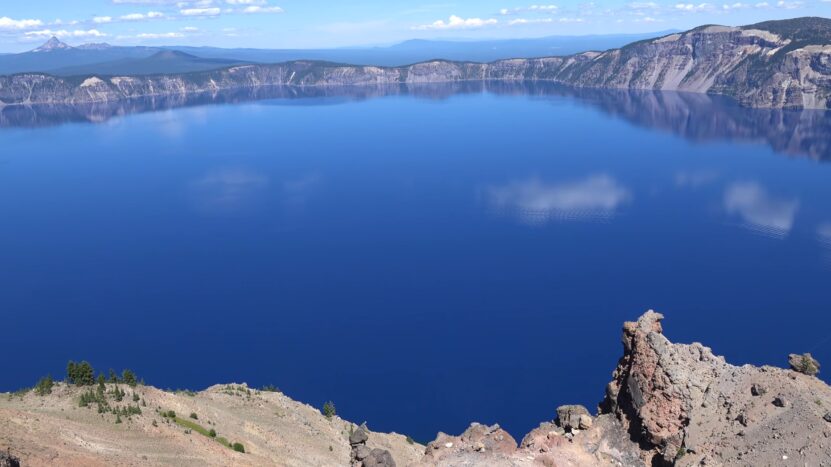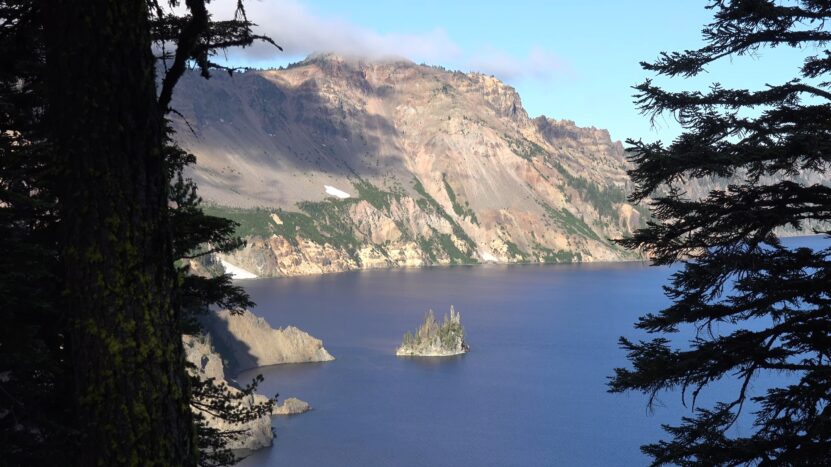Founded on May 22, 1902, Crater Lake National Park in Oregon is a natural marvel created from a cataclysmic volcanic eruption.
Nestled atop the Cascade Mountain Range, the park boasts lush forests, abundant wildlife, and a strikingly blue lake deserving of its moniker “lake majesty.”
The area’s geological past stretches back millennia and captivates modern visitors who swim, snowshoe, ski, hike, and bike across the mountainous landscape.
With a plethora of activities and thousands of acres to discover, the possibilities for adventure at Crater Lake are limitless.
The 7 most interesting Crater Lake National Park facts are below:
A World Record Holder

Crater Lake, located in the southern part of the Cascade Range in Oregon, USA, is a fascinating natural wonder. It was formed over 7,700 years ago when Mount Mazama, a volcanic peak, collapsed, creating a caldera. The caldera eventually filled with water over time, forming the deepest lake in the United States and a world record holder, with a depth of 1943 feet.
This lake’s depth is not only a spectacular feature of the Oregon National Park, but it also places Crater Lake among the top 10 deepest lakes globally. In fact, Crater Lake ranks as the ninth deepest lake in the world, according to the Global Lake Depth Database.
The crystal clear blue waters of Crater Lake, surrounded by sheer cliffs and old-growth forests, make it a popular destination for tourists from all over the world. The lake is also home to two islands, Wizard Island and Phantom Ship, which add to its unique beauty. Visitors can enjoy activities such as hiking, camping, fishing, and boat tours, making it an excellent spot for outdoor enthusiasts.
Furthermore, Crater Lake is not only a natural wonder but also a cultural treasure. The Klamath Native American tribe considers the lake a sacred site and believes it to be the home of their chief, Llao. The Klamath people have a long-standing relationship with Crater Lake, and their cultural heritage is closely tied to the area.
Extreme Temperature Fluctuations and the Need for Preparation

Crater Lake, located in the southern Cascade Range of Oregon, is a natural wonder that draws visitors from all over the world. However, the weather conditions at the lake can be quite extreme, with temperature fluctuations throughout the year.
During the winter months, the temperature at Crater Lake can drop dramatically, often reaching below freezing, with lows of around 18 degrees Fahrenheit. The lake’s high elevation of 6,100 feet above sea level means that heavy snowfall is also common, with snow covering the area from November to May. These conditions can make travel and outdoor activities challenging but also add to the natural beauty of the area.
In contrast, the summer months can be hot, with temperatures soaring up to 90 degrees Fahrenheit. The bright sun, combined with the high altitude, means visitors should take precautions to avoid sunburn and heat exhaustion. Additionally, sudden weather changes are common, and visitors should be prepared for sudden drops in temperature or even snowfall.
Camping at Crater Lake National Park
rater Lake National Park offers camping opportunities for visitors, with two campsites available for use. The main camping site, Mazama Village, provides over 200 sites for visitors to choose from, catering to both tent and RV camping. The site offers amenities such as electric hookups, showers, and other facilities, making it a popular choice for campers.
Mazama Village is located seven miles south of Crater Lake and offers visitors a convenient location to explore the area. The campsite is surrounded by towering Ponderosa pines, which provide shade and a serene atmosphere. The campsites are spacious, with ample room for families or groups of friends, and some even offer views of the stunning landscape.
In addition to Mazama Village, the park also offers a smaller campsite, Lost Creek Campground, which is located near the park’s North Entrance. This campsite offers a more rustic camping experience, with limited amenities and no electrical hookups, but it is an excellent option for those seeking a quieter camping experience.
Exploring the Crystal Clear Waters

Crater Lake, located in southern Oregon, is renowned for its crystal-clear waters, allowing visitors to see over 100 feet down into the lake’s depths. This unique feature of the lake makes it an excellent destination for boat tours, which are popular with visitors from all over the world. Sitting in a boat and exploring the pristine waters while observing the diverse creatures that live beneath the surface is truly a rare and spectacular experience.
The boat tours of Crater Lake are operated by the National Park Service and offer visitors a range of options, from guided tours to self-guided excursions. The tours are an excellent way to learn more about the lake’s history and geology, as well as to observe the unique wildlife that inhabits the area, such as bald eagles, otters, and rainbow trout.
Visitors can choose from two different boat tours at Crater Lake: the Wizard Island Tour and the Scenic Cruise. The Wizard Island Tour takes visitors to the island in the middle of the lake, where they can explore the island’s trails and take a refreshing swim in the clear waters. The Scenic Cruise, on the other hand, takes visitors on a tour around the entire lake, offering breathtaking views of the surrounding cliffs and forests.
Fascinating History: Formed by the Eruption of Mount Mazama
One of the most interesting facts about Crater Lake National Park is how it was formed. The park was created after the eruption of a volcano called Mount Mazama over 7,700 years ago. The eruption was one of the most significant in North America’s history, and it caused the mountain to collapse, leaving a deep crevice.
Over time, rainwater filled the crevice, forming what is now known as Crater Lake. The lake’s name reflects its origin, as it was formed in the crater left by Mount Mazama’s collapse. The lake’s water is renowned for its intense blue color, which is due to its depth and clarity.
The creation of Crater Lake National Park began in the late 19th century, with efforts to protect the area and its unique features. In 1902, President Theodore Roosevelt signed a bill designating Crater Lake as the country’s sixth national park. Since then, the park has been a popular destination for visitors from all over the world, drawn by its natural beauty and fascinating history.
Exploring the Unique Landscape with a Limited Trail System
Crater Lake National Park is unique in that it has relatively few hiking trails compared to other national parks. The park’s main attraction is the lake, which draws visitors from all over the world. However, there are still about five hiking trails available for visitors to explore, ranging in distance from 0.5 miles to 5 miles.
One of the most popular hiking trails in the park is the Garfield Peak Trail, which offers stunning views of the lake and the surrounding mountains. The trail is about 3.4 miles round trip and is considered moderately strenuous, with an elevation gain of 1,000 feet.
Another popular trail is the Cleetwood Cove Trail, which leads down to the lake’s edge and offers visitors the chance to take a refreshing swim in the crystal-clear waters. The trail is about 2.2 miles round trip and is steep and strenuous, with an elevation gain of 700 feet.
Heavy Snowfall and Unpredictable Weather Patterns
Crater Lake National Park experiences significant amounts of precipitation each year, with an average rainfall of around 66 inches. The park’s winter months are particularly notable for their heavy snowfall, with as much as 44 feet of snow accumulating during the season.
The park’s high elevation and location in the southern Cascade Range of Oregon contribute to the area’s significant precipitation levels. The snowfall is particularly impressive, and it is not uncommon for the snow to remain on the ground from November to May.
The heavy snowfall in Crater Lake National Park can make travel and outdoor activities challenging during the winter months. Many park facilities are closed during this time, and visitors should be prepared for the cold temperatures and difficult driving conditions. However, the snow also adds to the park’s unique beauty, and visitors can enjoy activities such as snowshoeing and cross-country skiing.
If you enjoy exploring natural wonders, you may also be interested in discovering the top 10 fascinating facts about Sequoia National Park.

